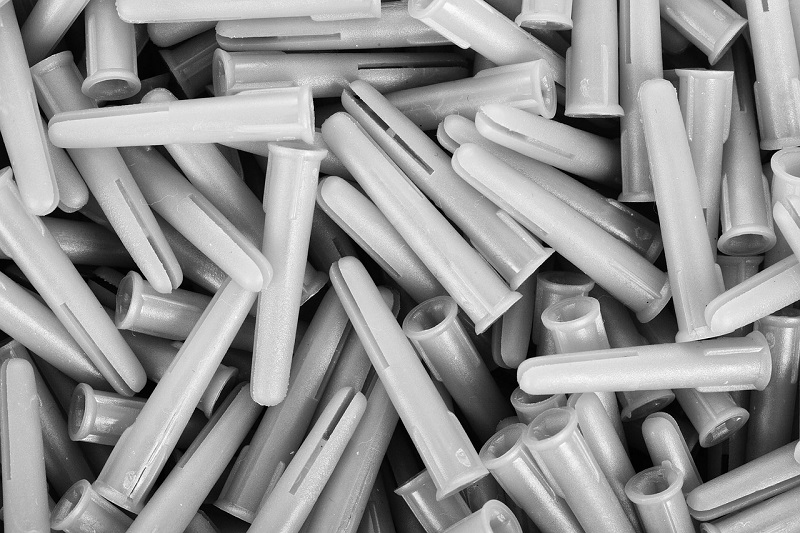Wall plug

|
Contents |
[edit] Outline
A wall plug (commonly called a rawl plug) is used to ensure screws driven into masonry walls provide a secure fixing. Without them, screws would not grip into masonry and would not provide adequate compressive force to ensure a secure, permanent fixing.
Installation usually involves ensuring first that the correct size plug is paired with the screw. As the screw must fit inside the plug, the hole to be drilled will be larger than it would be for the screw. The plug is inserted into the drilled hole and the screw is driven into the plug. As the screw penetrates the plug, it gradually forces the plug sides to expand outward, applying a compressive force against the masonry (which can be brick, block, concrete or plasterboard). The screw is tightened until it has fully penetrated into the plug, at which point it cannot be tightened any more.
Sometimes the screw turns indefinitely without tightening. This usually means the wrong size of plug has been used or the hole drilled is too big for the plug. One possible remedy is to take out the screw and take up the slack with matchsticks, filler, plaster pads or other material that will reduce the size of the hole, or to use a larger wall plug.
[edit] Composition
Typically, wall plugs are made of medium-duty, moulded plastic that can be used with a range of standard screws, from No 4 to No 14 sizes. They are usually tapered and profiled to increase their grip; they come in a range of profiles, colours and sizes.
Wall plugs are also supplied as extruded plastic – often straight tubes of 150mm-200mm lengths that must be cut to size according to requirements. But because they have straight sides, they must be cut shorter than the depth of the hole.
[edit] Threaded plugs
For screwing into less dense, friable walls, such as aerated concrete blocks, plugs are available with a thread on the outside; once screwed into the wall they form the socket for the screw and in all respects behave like ordinary wall plugs.
[edit] Nailable plugs
Nailable plugs come in various shapes and sizes and can be used with nails in masonry and plasterboard. They are useful when many fixing points must be made quickly. Both nail and plug are simply hammered-in as one fixing. Typical applications include fixing skirting boards, wall linings, battens and frames.
[edit] Related articles on Designing Buildings
Featured articles and news
RTPI leader to become new CIOB Chief Executive Officer
Dr Victoria Hills MRTPI, FICE to take over after Caroline Gumble’s departure.
Social and affordable housing, a long term plan for delivery
The “Delivering a Decade of Renewal for Social and Affordable Housing” strategy sets out future path.
A change to adoptive architecture
Effects of global weather warming on architectural detailing, material choice and human interaction.
The proposed publicly owned and backed subsidiary of Homes England, to facilitate new homes.
How big is the problem and what can we do to mitigate the effects?
Overheating guidance and tools for building designers
A number of cool guides to help with the heat.
The UK's Modern Industrial Strategy: A 10 year plan
Previous consultation criticism, current key elements and general support with some persisting reservations.
Building Safety Regulator reforms
New roles, new staff and a new fast track service pave the way for a single construction regulator.
Architectural Technologist CPDs and Communications
CIAT CPD… and how you can do it!
Cooling centres and cool spaces
Managing extreme heat in cities by directing the public to places for heat stress relief and water sources.
Winter gardens: A brief history and warm variations
Extending the season with glass in different forms and terms.
Restoring Great Yarmouth's Winter Gardens
Transforming one of the least sustainable constructions imaginable.
Construction Skills Mission Board launch sector drive
Newly formed government and industry collaboration set strategy for recruiting an additional 100,000 construction workers a year.
New Architects Code comes into effect in September 2025
ARB Architects Code of Conduct and Practice available with ongoing consultation regarding guidance.
Welsh Skills Body (Medr) launches ambitious plan
The new skills body brings together funding and regulation of tertiary education and research for the devolved nation.
Paul Gandy FCIOB announced as next CIOB President
Former Tilbury Douglas CEO takes helm.
UK Infrastructure: A 10 Year Strategy. In brief with reactions
With the National Infrastructure and Service Transformation Authority (NISTA).






















